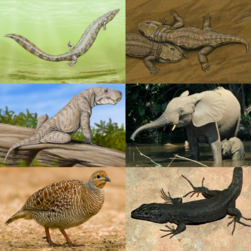
Back شبيهات الزواحف Arabic شبيهات الزواحف ARZ Reptiliomorpha Azerbaijani সরীসৃপরুপী প্রাণী Bengali/Bangla Reptiliomorfs Catalan Reptiliomorpha German Reptiliomorpha Esperanto Reptiliomorpha Spanish Reptiliomorpha Basque خزندهریختان Persian
| Reptiliomorpha | |
|---|---|
 | |
| Diversity of clade Reptiliomorpha.
1st row (stem group): Archeria crassidica, Seymouria sanjuanensis; 2nd row (Synapsida): Dinogorgon rubidgei, Loxodonta cyclotis; 3rd row (Sauropsida/Reptilia): Ortygornis pondicerianus, Podarcis muralis. | |
| Scientific classification | |
| Domain: | Eukaryota |
| Kingdom: | Animalia |
| Phylum: | Chordata |
| Superclass: | Tetrapoda |
| Clade: | Reptiliomorpha Säve-Söderbergh, 1934 |
| Subgroups | |
| Synonyms | |
|
Pan-Amniota Rowe, 2004[1] | |
Reptiliomorpha (meaning reptile-shaped; in PhyloCode known as Pan-Amniota[2][3]) is a clade containing the amniotes and those tetrapods that share a more recent common ancestor with amniotes than with living amphibians (lissamphibians). It was defined by Michel Laurin (2001) and Vallin and Laurin (2004) as the largest clade that includes Homo sapiens, but not Ascaphus truei (tailed frog).[4][5] Laurin and Reisz (2020) defined Pan-Amniota as the largest total clade containing Homo sapiens, but not Pipa pipa, Caecilia tentaculata, and Siren lacertina.[2][3]
The informal variant of the name, "reptiliomorphs", is also occasionally used to refer to stem-amniotes, i.e. a grade of reptile-like tetrapods that are more closely related to amniotes than they are to lissamphibians, but are not amniotes themselves; the name is used in this meaning e.g. by Ruta, Coates and Quicke (2003).[6] An alternative name, "Anthracosauria", is also commonly used for the group, but is confusingly also used for a more primitive grade of reptiliomorphs (Embolomeri) by Benton.[7] While both anthracosaurs and/or embolomeres are suggested to be reptiliomorphs closer to amniotes, some recent studies either retain them as amphibians or argue that their relationships are still ambiguous and are more likely to be stem-tetrapods.[8][9][10]
As the exact phylogenetic position of Lissamphibia within Tetrapoda remains uncertain, it also remains controversial which fossil tetrapods are more closely related to amniotes than to lissamphibians, and thus, which ones of them were reptiliomorphs in any meaning of the word. The two major hypotheses for lissamphibian origins are that they are either descendants of dissorophoid temnospondyls or microsaurian "lepospondyls". If the former (the "temnospondyl hypothesis") is true, then Reptiliomorpha includes all tetrapod groups that are closer to amniotes than to temnospondyls. These include the diadectomorphs, seymouriamorphs, most or all "lepospondyls", gephyrostegids, and possibly the embolomeres and chroniosuchians.[6] In addition, several "anthracosaur" genera of uncertain taxonomic placement would also probably qualify as reptiliomorphs, including Solenodonsaurus, Eldeceeon, Silvanerpeton, and Casineria. However, if lissamphibians originated among the lepospondyls according to the "lepospondyl hypothesis", then Reptiliomorpha refers to groups that are closer to amniotes than to lepospondyls. Few non-amniote groups would count as reptiliomorphs under this definition, although the diadectomorphs are among those that qualify.[11]
- ^ Rowe, T. (2004). "Chordate phylogeny and development". Assembling the Tree of Life. J. Cracraft and M. J. Donoghue, eds. Oxford: Oxford University Press. pp. 384–409. ISBN 0-19-517234-5.
- ^ a b de Queiroz, K.; Cantino, P. D.; Gauthier, J. A., eds. (2020). "Pan-Amniota T. Rowe 2004 [M. Laurin and T. R. Smithson], converted clade name". Phylonyms: A Companion to the PhyloCode. Boca Raton: CRC Press. pp. 789–792. ISBN 978-1-138-33293-5.
- ^ a b "Pan-Amniota". RegNum.
- ^ Laurin, M. (2001). "L'utilisation de la taxonomie phylogénétique en paléontologie: avantages et inconvénients". Biosystema. 19: 197–211.
- ^ Vallin, Grégoire; Laurin, Michel (2004). "Cranial morphology and affinities of Microbrachis, and a reappraisal of the phylogeny and lifestyle of the first amphibians". Journal of Vertebrate Paleontology. 24 (1): 56–72. doi:10.1671/5.1. S2CID 26700362.
- ^ a b Ruta, M.; Coates, M.I.; Quicke, D.L.J. (2003). "Early tetrapod relationships revisited". Biological Reviews. 78 (2): 251–345. doi:10.1017/S1464793102006103. PMID 12803423. S2CID 31298396.
- ^ Benton, M. J. (2000), Vertebrate Paleontology, 2nd Ed. Blackwell Science Ltd 3rd ed. 2004 – see also taxonomic hierarchy of the vertebrates, according to Benton 2004
- ^ Hodnett, John-Paul M.; Lucas, Spencer G. (2018). "A nonmarine Late Pennsylvanian vertebrate assemblage in a marine bromalite from the Manzanita Mountains, Bernalillo County, New Mexico". New Mexico Museum of Natural History and Science Bulletin. 79: 251–260.
- ^ Adams, Gabrielle R. (2020). "3. A phylogenetic analysis of NSM 994GF1.1 to determine the placement of embolomeres in the tetrapod tree". Description of Calligenethlon watsoni based on computed tomography and resulting implications for the phylogenetic placement of embolomeres (MSc thesis). Carleton University.
- ^ Pardo, J. D. (2023). "New information on the neurocranium of Archeria crassidisca and the relationships of the Embolomeri". Zoological Journal of the Linnean Society. doi:10.1093/zoolinnean/zlad156.
- ^ Cite error: The named reference
LR99was invoked but never defined (see the help page).